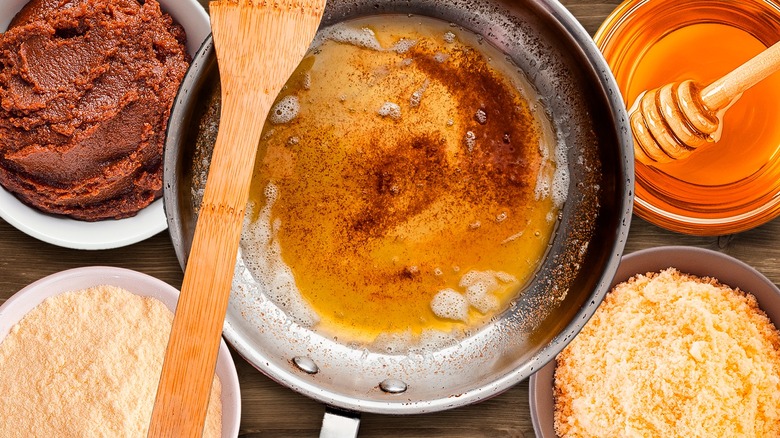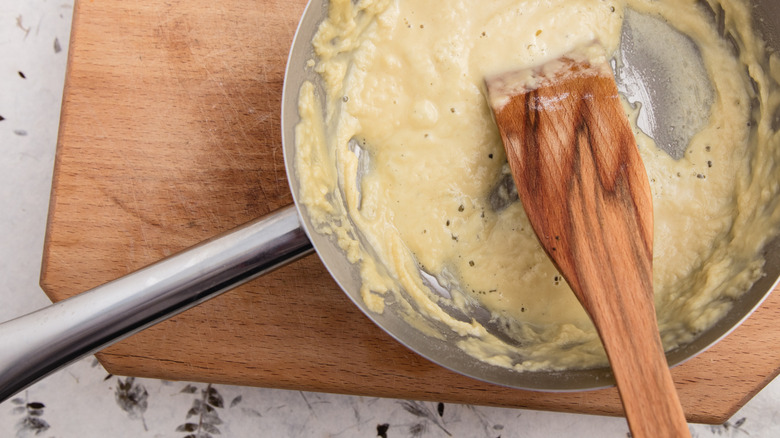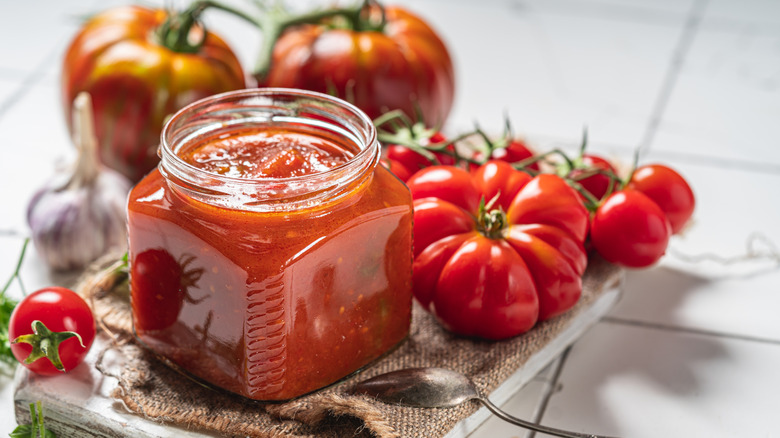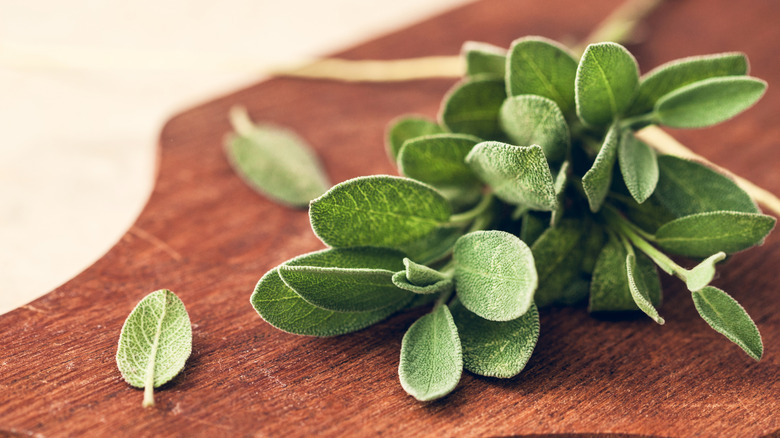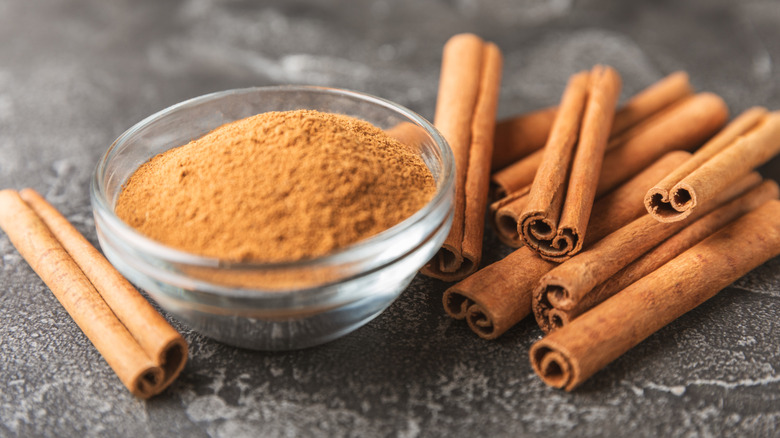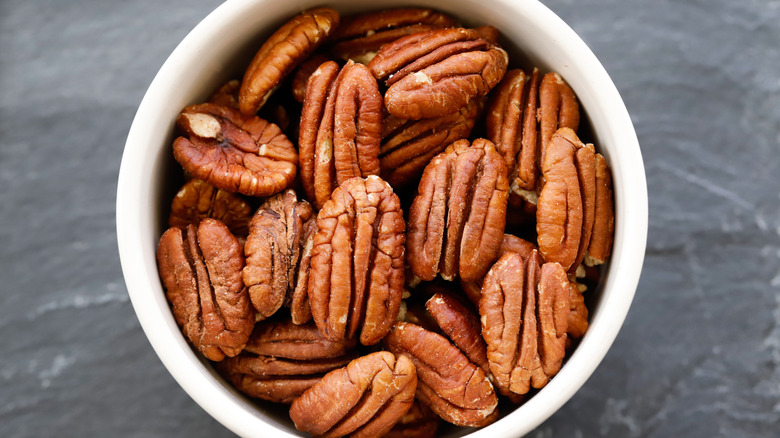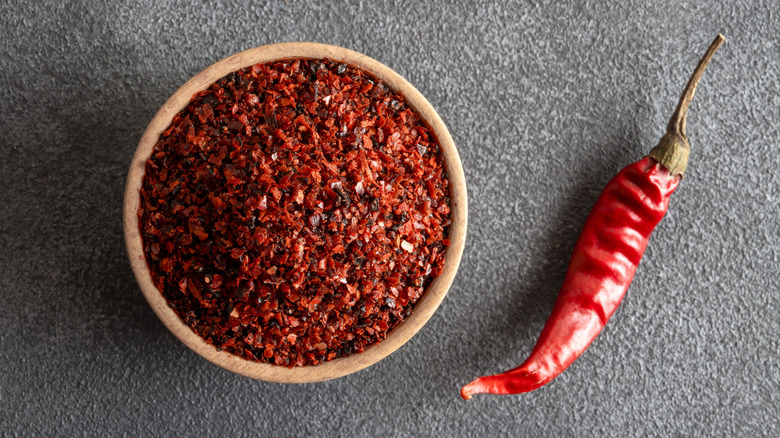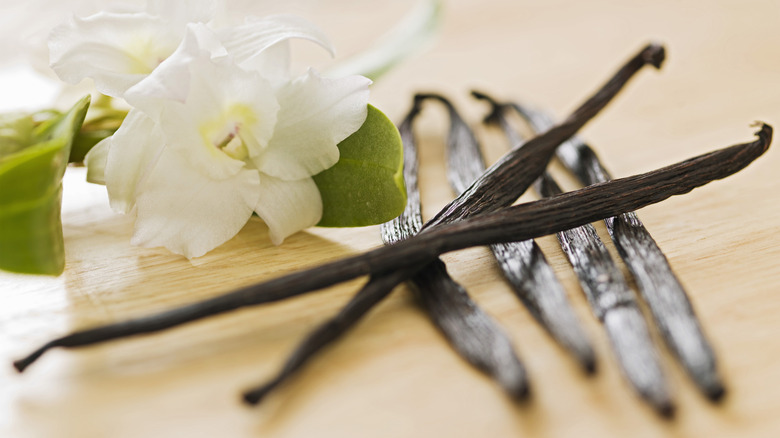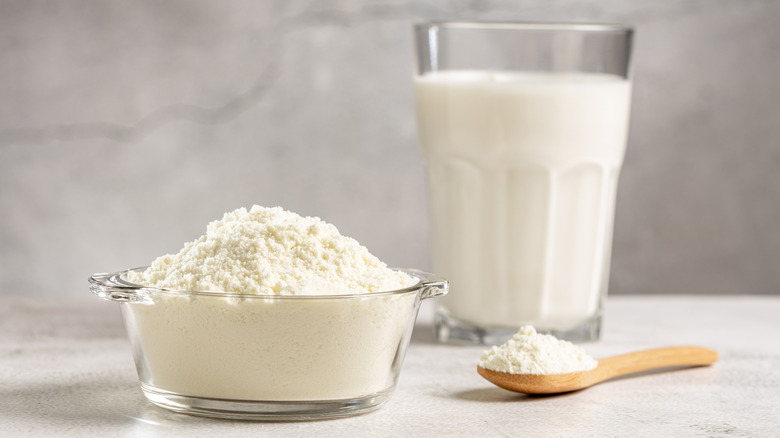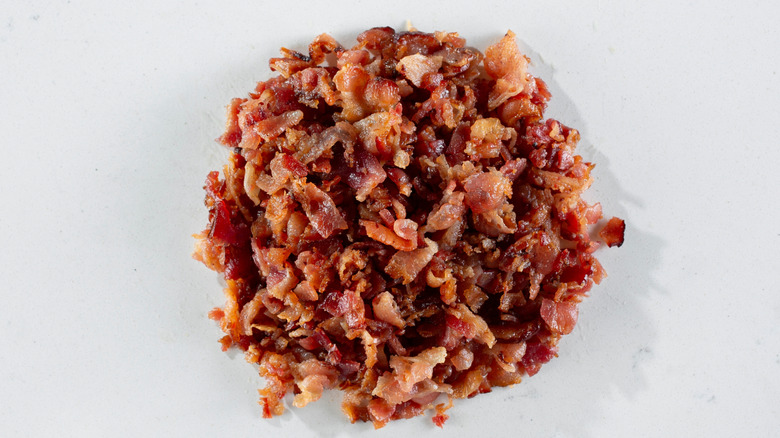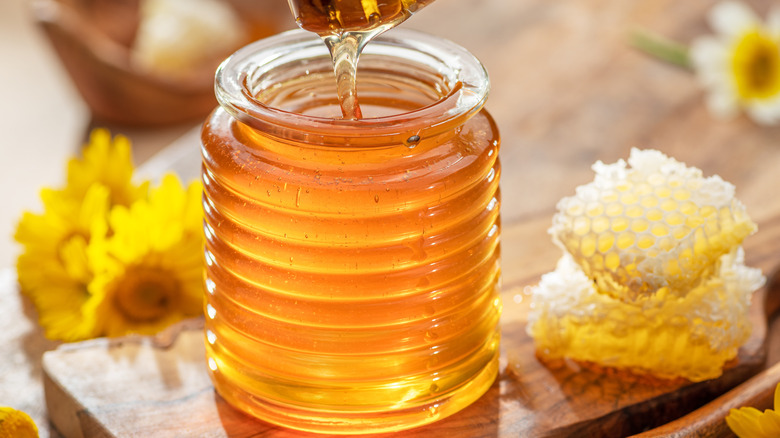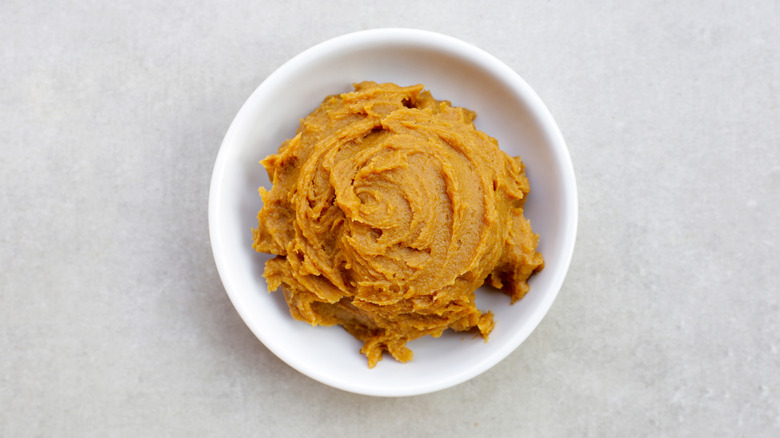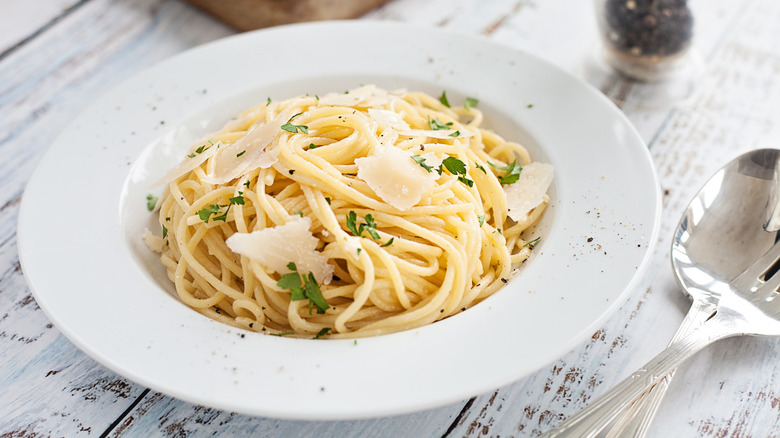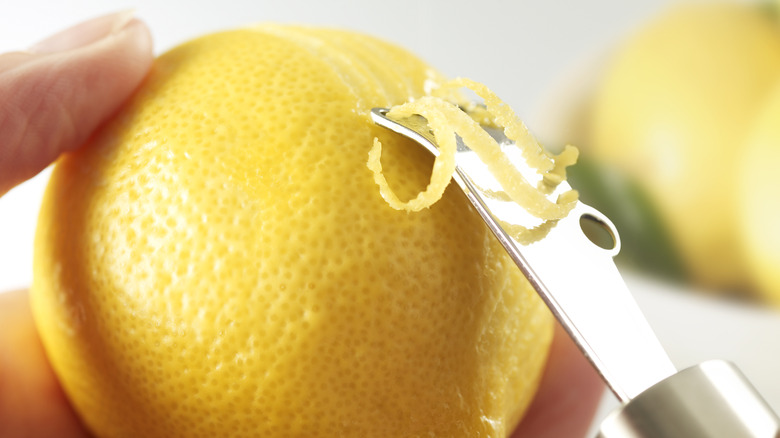15 Ingredients You Should Be Adding To Brown Butter
Butter is a beloved staple used in many dishes and desserts but brown butter elevates these further with a deep, rich nutty flavor. You can make brown butter pretty easily using unsalted butter and a pan. For something so simple to create, it can be a game-changer in the kitchen. But we wanted to figure out how to enrich it further, so we spoke with some experts to give us their top ingredients you should be adding to brown butter.
Marissa Stevens is a food blogger and the creator behind Pinch and Swirl, Scott Groth is a professional chef and creator of I'd Rather Be a Chef, and Jennifer Pallian is a food scientist and writer at Foodess. We'll cover how to integrate the ingredient, why it works with brown butter, and give you valuable insights on how to use it or what other foods it works well with. "Brown butter is one of my favorite foundational ingredients, and I'm excited to offer some unique ways to elevate it," Groth says.
From sweet to salty to nutty, these additions can amplify the brown butter's flavor and provide versatility; this allows for more creativity in cooking and baking, whether you want to employ it to bake chocolate chip cookies or pour it over chicken or protein as a sauce. By the time you're done reading this, you'll have a long list of fresh combinations to entice your taste buds.
1. Toasted flour
The addition of toasted flour creates a deep, warm, and thick sauce rather than the thin liquid you come to expect with freshly made brown butter. Marissa Stevens says the toasted flour forms the foundation for a rich, nutty roux when paired with the butter. Gently toast the flour in a heated pan, stirring until it turns a brownish hue, which gives it that nutty taste that works so well with the brown butter's similar profile. The level of toastiness is up to you, then set the flour aside and work on your brown butter. "Add the flour once your butter reaches the golden-brown stage to keep the butter's warm, caramelized notes intact," says Stevens.
Use the butter potion as the base of a flavor-loaded sauce to pour over meat or veggies. It makes a great substitute for turkey drippings, as Stevens suggests, and is a unique way to offer color and flavor to food. Add a bit of milk to turn it into creamy country gravy or opt for chicken or turkey stock if you prefer something dairy-free. This particular brown butter takes time and effort as you need to consistently stir, but it can yield impressive results.
2. Tomato
Adding this red fruit into the nutty elixir might seem strange but tomato brown butter is the ultimate condiment. This is because the mixture creates a balance of sweetness, acidity, and nuttiness for a complex flavor profile that you'll crave after you try it. To make it, you'll need to puree the tomatoes in a blender and then strain it, keeping the red liquid aside from the pulp. For added complexity, you could roast the tomatoes before blending for a slight sweetness.
Set the tomatoes aside and then brown your butter. Now, you're ready to incorporate them for an acidic, buttery sauce. You can refrigerate tomato butter until it firms up. The firmer versions create a tasty spread for sandwiches or slathered onto toast for a pan con tomate-inspired appetizer. The tomato brown butter has the well-known nutty scent with the nuance of the red fruit that works well when mix with chopped rosemary for added fragrance and a piney, herbal taste. The vibrant butter can make basics like pasta taste like you're digging into a fine dining meal.
3. Sage
Sage has been a culinary staple for thousands of years and can bring its peppery, earthy, almost woodsy taste to brown butter. It can create an unforgettable combination to use in dishes like ravioli,roasted vegetables, or drizzled onto grilled meats. Toss in a few fresh sage leaves during the final minutes of browning the butter to give it enough time to infuse without burning it.
"Be sure to add [sage] once the butter is foamy, just before it reaches its golden-brown hue," Scott Groth explains. The leaves will crisp up, which you can include in your meal for added texture. You may leave the leaves whole or cut them into ribbons to make them easier to eat.
Fresh sage is ideal for its vibrancy, but dried sage works. When using dried, you'll want to incorporate less than you would fresh as the dried sage can be slightly bitter when used in excess. Crack in some pepper or crushed garlic for added flavor. Use this melty, golden butter to turn your weeknight meal into a standout dish.
4. Cinnamon
There are many magical food combinations and cinnamon with butter is one of them. It has a cozy essence that reminds you of autumn eats on a chilly evening. Cinnamon brown butter can make all your delicacies or cocktails more scrumptious. Whisk in the ground, warming spice into your brown butter mixture, making sure to do so after you've taken it off the heat.
It's delicious as is, but try adding a hint of vanilla and maple to make a sweet butter to spread on toast or over your freshly baked treats. You could create a thicker version of cinnamon butter by adding powdered sugar to make a cinnamon brown butter glaze or frosting to top all your favorite desserts. For something summery, slather the liquid onto grilled peaches and top with ice cream for a juicy, fruity dessert.
Go in a different direction by utilizing the buttery bliss as a way to fat-wash your whiskey in brown butter. This creates a rich mouthfeel and nutty, caramelized taste in your beverages. The cinnamon component works nicely with the apples in spiked apple cider or the cinnamon you'd find in a hot toddy. Use cinnamon sticks as a garnish to double up on the spiced goodness.
5. Nuts
Brown butter already has a heightened taste, but the idea of adding nuts can bring the golden fat to a higher level. Elevate the flavor of brown butter by adding nuts like almonds, cashews, or pecans. After the butter is melted, toss in the nuts. As the butter browns the nuts also get a chance to toast up, bringing in an earthy aroma and taste that will leave your mouth watering. Just make sure to consistently stir to avoid burning. If you're using chopped nuts, opt for pan or oven-toast the nuts separately, then mix them into the butter after it's browned.
We especially love the versatility the nuts provide. This can be a sweet or savory base depending on what you want to use it in or if you include any more ingredients. Salt and sage can turn this into a savory sauce for your pasta of choice. Use pecan brown butter to make heavenly ice cream or toast hazelnuts in brown butter for an epic snack. The nuts bring a unique taste as well as texture into your sauce when you want it to be more than a liquid.
6. Chiles
The decadence of creamy butter works wonders when paired with something spicy. The two components balance each other in the best way. Jennifer Pallian suggests an epic combination of dried chiles (or chili flakes), mustard seeds, and curry leaves. "This combination draws inspiration from Tadka in Indian cooking, where these ingredients are tempered in hot fat to release their essential oils," Pallian explains.
Toss in dried chiles once the butter is melted but before it begins to brown, and keep a window open to ventilate the kitchen since the chile's capsaicin can circulate into the air. Take the mixture off the heat once the butter browns and the add-ins are crisp. This creates a nutty sauce that's bursting with heat and aroma and takes the browned butter to "flavor bomb dot com," per Pallian.
This browned butter ingredient goes great over cooked lentils or grilled eggplant. But depending on what you plan to make, there's room to experiment with different flavor profiles like a spicy and earthy brown butter for pasta made with red chili pepper flakes and sage.
7. Vanilla beans or extract
Vanilla amplifies brown butter to act as a flavor enhancer for desserts, drinks, and dishes alike. Thanks to the nut-like taste of brown butter, the vanilla intensifies in caramel or butterscotch flavor without being overly aromatic. Use vanilla extract or pods to get the desired taste. The pods will provide incredible visual allure from their tiny flecks, whereas the extract has alcohol which can offer its nuanced flavor. If you're concerned about expenses, you need only a little bit to impact the brown butter's flavor.
A rich butter sauce with vanilla has an enticing aroma and versatility that makes it a fierce match for plenty of dishes. You can never go wrong with chocolate chip cookies but it also works in granola. If you don't want to commit to one dessert, try it as a frosting to decorate any confection with a delicate infusion. For something savory, use it as a sauce for pasta like butternut squash ravioli, where its inclusion can lift the acidity of the tomatoes.
8. Powdered milk
Milk powder is an unexpected ingredient that will elevate brown butter by offering a toasty taste. Since they're both dairy-based products, you'll find that they work in harmony without overpowering each other. But they have something else in common: milk solids. In brown butter, milk solids come into play when the Maillard reaction causes the butter's water content to evaporate — leaving you with the fat and dark-colored milk solids that you usually see at the bottom of your pan. Since powdered milk is also milk solids it produces a similar, rich result when incorporated.
Whisk your milk powder in once the butter starts to foam, making sure that it fully dissolves. Seeing as the shelf-stable pantry item is a powder, it adds more of those dark crumbly milk solid bits to the sauce (which is why can't duplicate the result when using regular milk). You need only a couple of tablespoons for each stick of butter used. Use this extra-strength butter in anything from cakes to brownies. It uniquely intensifies the color, texture, and flavor of the brown butter.
9. Garlic
Trust us when we say you'll want to use garlic brown butter in all your savory dishes. It makes an aromatic combination that will inevitably waft throughout your entire house, beckoning all to come to see what's cooking. You may cut the garlic based on texture preference. Halfing garlic cloves allows you to easily remove them, while minced or grated garlic will become a textural part of the sauce. Make your pick and add it to the butter, stirring thoroughly until the browning process begins.
Since garlic is prone to burning, you want to keep it on medium heat. This will effectively cook the garlic, transforming the butter into a fragrant, savory liquid with a nutty, lightly sweet essence. Take it off the heat and you're ready to pour it into something like creamy garlic mashed potatoes. You may, however, throw in more ingredients to bolster the taste based on your meal. Including fresh rosemary can bring a citrusy, piney taste that makes a drool-worthy sauce for pasta or steak.
10. Bacon
This may be one of the more unexpected ingredients you should be adding to brown butter, but you'd be surprised at how much it can offer. Bacon supplies the butter with a savory, smoky element that can transform your meal as well as add salinity. Dice the bacon into small pieces and cook it separately. Otherwise, the bits will burn with the time it takes to brown the butter. You could opt for thick-cut bacon if you want more noticeable pieces for the sauce. Make the brown butter first, and then integrate the meat into it.
Along with the bacon, you can integrate other components like onion and garlic to make a well-rounded sauce. This makes a scrumptious base for tortellini or steak. Or integrate it into macaroni and cheese for a luxurious worthy of seconds and potentially thirds. The liquid gold gets a bold crunch with a salty, smoky upgrade from the bacon that, together, creates a rich seasoning for your meals. We think this would be incredible on popcorn when plain butter doesn't cut it.
11. Honey
You can your brown butter into a sweetened condiment with honey, which will have nuanced notes based on the type you use. There are many types of honey to pick from if you want to encourage unique flavors into your seasoning while complementing the flavors of your food. Wildflower honey should be pretty easy to locate and has an approachable taste — it is mild with subtle floral notes. Avocado honey has a nutty taste and a darker hue that would complement the color and flavor profile of brown butter, but it can be a tad bitter.
The honey brown butter creates a magical mixture that's sweet and fragrant. Mix in a sprinkle of salt to enhance the sweetness,then refrigerate it so it hardens. You could go a different route by whipping it. Place the brown butter in a bowl over ice, then drizzle the honey in, and whisk until it establishes a lighter, fluffier texture. Now you're ready to use the buttery delight however you want. It makes a tasty addition to pancakes or waffles to make a basic weekend breakfast taste like an expensive meal. But you could turn it into savory sauce with garlic to use on salmon or your favorite fish.
12. Miso paste
When you want an ingredient that packs a punch of umami, miso paste might be your bestie. What you need to know about miso is that its fermented paste is usually made from soybeans, but you can find other versions created with different beans or grains like rice. The taste may differ based on the miso's main ingredient or age. For example, barley may have a light sweetness to it while rice may be sour. Whichever you choose, the concentrated flavor means your container can last for recipes to come.
When you whisk the soybean paste into the partially cooled brown butter, the paste dissolves, and the heat from the Maillard reaction creates new flavor compounds. According to Jennifer Pallian, "These new compounds give browned butter a more complex, savory profile which can enhance the perception of umami when paired with other umami-rich ingredients like miso."
Miso-brown butter has a delightfully complex taste that offers more than a salted component. Pallian recommends drizzling the concoction over pan-fried fish, steamed tofu, or roasted sweet potatoes, or tossing it with noodles, while Scott Groth suggests using it to add flavor to pasta. You could also refrigerate it to solidify and then smear it onto a fresh, crusty piece of bread.
13. Parmesan
Butter and cheese are a combination you'll often see in dishes like pasta and sandwiches, so you can create a deep flavor with parmesan and brown butter. Both of cheese and parmesan have a nut-forward taste that you can use to your advantage when creating the easiest decadent pasta. This is a simple yet heavy meal you'll never forget. You may use salted butter for this occasion to provide a savory flavor to intensify the meal.
Make your brown butter and add freshly grated parm directly into the liquid, stirring thoroughly. Let this simmer for a few minutes until the cheese blends into the concoction. This creates a thicker sauce to beautifully coat your pasta. You could add herbs, like oregano, basil, or parsley, to bring an earthy lift or lean further into the richness by adding garlic and cream. Sprinkle additional grated parmesan onto your plated meal for added texture. This is one of those meals that can taste like it costs a lot of money but doesn't require fancy ingredients.
14. Citrus zest
"Incorporating citrus zest right after the butter browns adds brightness and a subtle tang," Scott Groth says. Take the butter off the heat before adding the zest, or it can easily fry. The oils from the rind provide a tangy burst that releases once added to the warmth of the melted butter. You could stick to one citrus or incorporate multiple together for complexity, such as a tangy lemon and orange brown butter or a grapefruit one. You'll quickly realize how many options there are.
The bright sauce pairs exceptionally well with pasta or seafood like scallops or grilled salmon. Chopped shallots or herbs such as basil or thyme can complement the fish or protein as well. You can also use the buttery citrus sauce for sweet treats. Groth recommends that you "Use it in baked goods like lemon cakes to balance richness with acidity." Lemon bars can get an upgrade with zesty lemon brown butter. This versatile version of brown butter will get a lot of use for desserts and savory foods alike.
15. Balsamic vinegar or glaze
Balsamic vinegar brings a complex flavor profile that's tart but sweet with notes of fig, molasses, or prune. Incorporating it in brown butter couldn't be simpler; drizzle it into your already-made brown butter, stir, and you're ready to serve. When using balsamic glaze, just note that it has a viscous, tacky consistency that can slightly thicken up the brown butter to create a flavorful sauce. For a similar effect, you could make a balsamic vinegar reduction.
Whichever you opt for, it brightens up your favorite dishes with a sour and sweet sophistication. Feel free to add lemon juice if you're seeking additional tartness. Enjoy this with veggies and protein like grilled asparagus or baked salmon. You'll see recipes using butter or balsamic vinegar, so combining them makes an elevated way to dine. Pour the sauce directly onto the food or leave it in a serving bowl so your family can spoon it on themselves.
